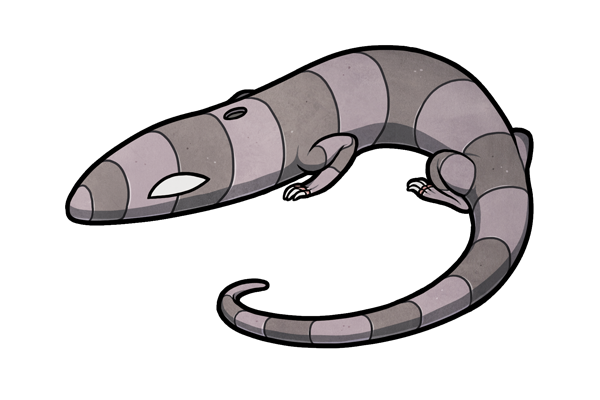

dovadroni
the musical boxes
prefix dova suffix droni
foram a cephnissini
physical appearance
The dovadroni /ˈdoʊvədroʊni/ is a pale purple and pink stranger with rounded features. Its surface is hard, cool, and dusty to the touch, leaving a white powder behind on anything it comes in contact with. Its flesh is barely flexible, and it possesses a body cavity filled with fine, white sand. Its off-white claws are soft and chalky to the touch, and grow continuously over the course of dovadroni's life to make up for natural breakage and wear. It has a small, round hole in its back, which is lined with hard flesh, and leads into the dovadroni's body cavity. It lacks a mouth, or any other distinguishing features. The dovadroni has no particular odor beyond a vaguely chalky filling of the nostrils. While it does not make a breathing sound, its sides do rise and fall slightly in a rhythmic manner, as though inhaling and exhaling.
While its stiff skin makes it difficult to cut open, the dovadroni can still be grievously injured by heavy blows, such as the impact from a crowbar. The dovadroni's regenerative ability is minimal, with the strain regenerating from only surface-level abrasions, and only after several weeks of dormancy. Exposure to moisture makes its flesh more flexible, without causing any harm to the dovadroni. Water evaporates from its surface at an accelerated rate, making any such periods of increased flexibility short-lived at best.
The dovadroni is also negatively affected by sound. Any sound of over 59 decibels causes it to display slight cracks in its surface, while sounds louder than 71 decibels crumble the dovadroni outright. Damp dovadroni appear less vulnerable to loud sounds.
The dovadroni speaks with the twinkling tones of a music box, a sound accompanied by a light, grinding whirr.
the winding of a metal spring beneath a familiar tune.

environment and generation
The dovadroni appears in a wide range of locations, but prefers large, sprawling, non-residential areas, such as hospitals, universities, government buildings, and shopping malls. It generates only in quiet, low-traffic areas, such as vacant building wings, empty storefronts, locked hallways, or quiet storage rooms, but only very rarely presents itself in buildings that have been completely abandoned. It is particularly common amongst the plywood walls and clear plastic sheets of suspended construction or renovation projects, although never during ongoing construction.
The dovadroni first emerges in a small, short-limbed form, which crawls from place to place and grows larger with a soft clanking sound, as though it were a mechanical device being wound up. It takes between two and three weeks for the dovadroni to reach full maturity.
behaviour and effects
The dovadroni's disposition is subdued and reclusive. It paces forward with careful, even steps, and as it moves, its chalk-like claws leave behind small white lines, thus tracing the dovadroni's path within its environment. Due to its relatively inflexible exterior, it is slow-moving, and tends to spend much of its time in a stationary position. When at rest, it fills the air with its chiming, musical voice. It tends to remain silent more often than not. There is no observable pattern to the dovadroni's vocalization, and certain individuals can even go for years without making a single sound.
Because of its vulnerability to loud sounds, the dovadroni grows nervous around audio louder than 35 decibels, and a nervous dovadroni is prone to repetitive finger motions and a reluctant raising and lowering of the head. The presence of dust seems to calm the dovadroni, and once dust begins to accumulate upon its surface, it will forego all other movements in order to allow itself to become completely coated.
Over time, the dovadroni's voice has a tendency to jam. Half of dovadroni are mute within three years, and 95% are mute within ten years. The dovadroni reacts with physical pain when its voice jams, and it takes several hours of slow, seething shudders for them to begin moving once more. This tendency to jam is exacerbated by repeated exposure to audio.
interactions with sensitives
The dovadroni is uneasy around sensitives, but not wholly asocial. It tends to move away from any sensitive who approaches it, but if cornered, allows itself to be stroked and petted without fear. It also moves away from aggressive strangers, but does not fight back or display any other defensive behaviours.
The dovadroni's quiet, music box-like voice is pleasant and melodic to any listener. Its voice resists memorization or transcription in all forms. Even a sensitive with an advanced musical ear and background transcribes only a discordant, jarring melody, even though they believe themselves, at the time, to be writing each note correctly. Because of this, it is impossible to tell whether all dovadroni play the same tune throughout their lives, or whether the tune varies over time and between individuals.
Encounters with dovadroni cause 56% of sensitives to lose the ability to memorize melodies, while 44% display greatly increased aptitude towards remembering music. This effect is short-lived, persisting for only two to three days.
Sensitives present at the moment when the dovadroni's voice jams run the risk of developing a moderate to severe stutter.
aging and death
As the dovadroni ages, its threshold for tolerating audio grows lower, and its motions become lagging and more trembling. By the end of its life, even the tap of an errant footstep or a sharp intake of breath can be enough to crack its body. The dovadroni dies once its inner sand spills out, all fragments of its skin and flesh decaying into further sand over the coming weeks.



